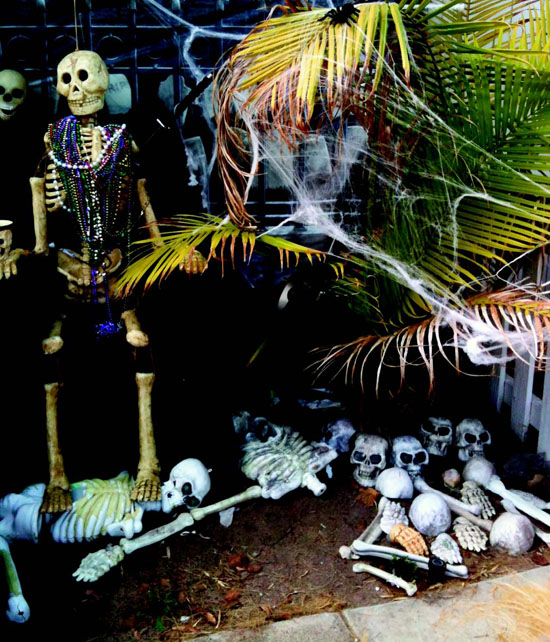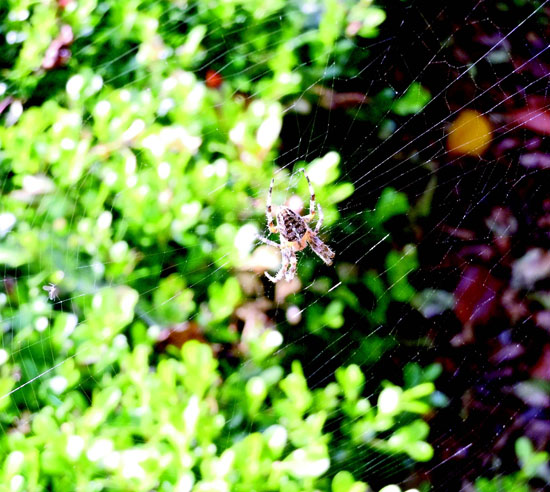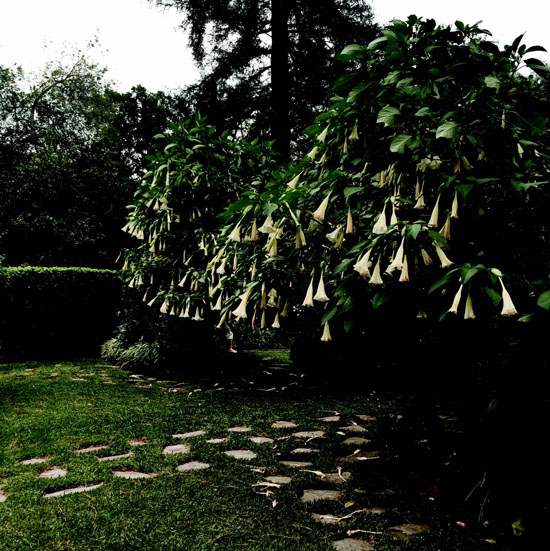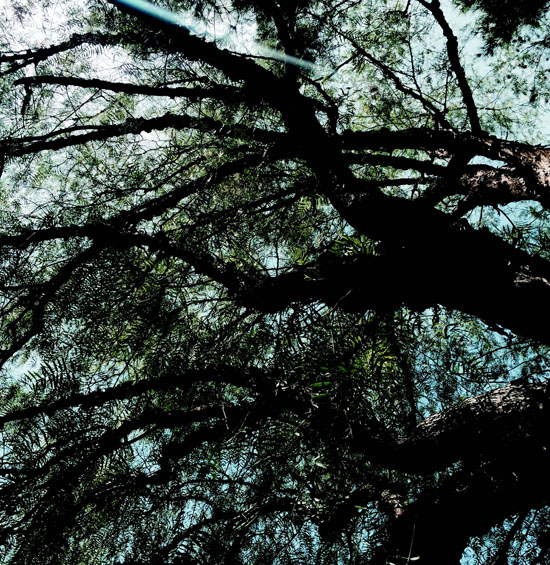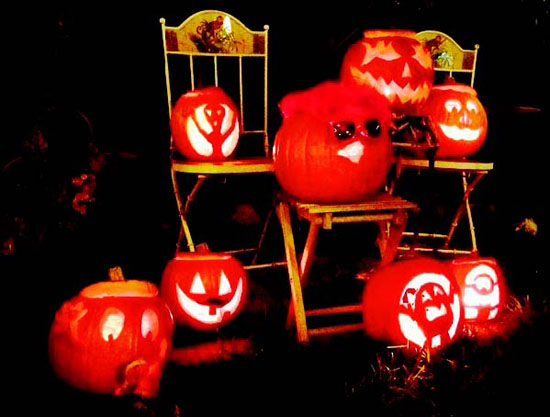 | | | Jack-o'-lanterns light up the landscape. Photos Cynthia Brian | | | | | | The season of screams and scares is officially here! Halloween is right around the corner, and it's time to embrace your inner ghoul. With only a few days left until a haunted eve, a walk in the park or around your personal garden will spark your spooktacular spirit as you encounter everyday species that ignite eerie imaginings, yet are friendly visitors. It's time to put out our mystical welcome mat.
 Children have feared spiders since the days of learning the nursery rhyme "Little Miss Muffet." We may not want them living in our homes, but in the garden spiders are considered beneficial bugs. There are generally two types of spiders: the weavers and the hunters. The big, beautiful, yet scary looking yellow and black argiope spider (Golden orb weaver) spins a web that catches garden predators twice her size while the hunters, the wolf spider and the crab spider, ambush their prey. Even their names evoke Halloween myths. These helpful arthropods (meaning eight legs) are considered more efficient eaters than our feathered friends eradicating aphids, spider mites, leafhoppers, armyworms, caterpillars, beetles, thrips and other nuisances. Don't squish the spiders nor destroy their webs because spiders are positive pest patrollers of our secret oasis.
Children have feared spiders since the days of learning the nursery rhyme "Little Miss Muffet." We may not want them living in our homes, but in the garden spiders are considered beneficial bugs. There are generally two types of spiders: the weavers and the hunters. The big, beautiful, yet scary looking yellow and black argiope spider (Golden orb weaver) spins a web that catches garden predators twice her size while the hunters, the wolf spider and the crab spider, ambush their prey. Even their names evoke Halloween myths. These helpful arthropods (meaning eight legs) are considered more efficient eaters than our feathered friends eradicating aphids, spider mites, leafhoppers, armyworms, caterpillars, beetles, thrips and other nuisances. Don't squish the spiders nor destroy their webs because spiders are positive pest patrollers of our secret oasis.
 Allium sativum is renowned for repelling vampires. But the next time you witness darting dive-bombers of the dark, hide the garlic to usher in the bats. Contrary to common thought, these North American "vampires" do not attack people. Mosquitoes bite people and bats eat more than 600 mosquitoes per hour. Their droppings are rich in nitrogen and they guard gardens from invasive insects. If you have a pool, you'll witness them skimming the water at twilight.
Allium sativum is renowned for repelling vampires. But the next time you witness darting dive-bombers of the dark, hide the garlic to usher in the bats. Contrary to common thought, these North American "vampires" do not attack people. Mosquitoes bite people and bats eat more than 600 mosquitoes per hour. Their droppings are rich in nitrogen and they guard gardens from invasive insects. If you have a pool, you'll witness them skimming the water at twilight.
 Many people are frightened of snakes, but finding a snake in the grass is a good omen. Most snakes are not poisonous and the most common snakes we find in our gardens are the garter or king snake. Rattlesnakes are venomous and like all pit vipers have thick triangular heads, easily distinguishable from their docile, non-poisonous relatives. Snakes eat mice, rats, and other rodents as well as snails and slugs.
Many people are frightened of snakes, but finding a snake in the grass is a good omen. Most snakes are not poisonous and the most common snakes we find in our gardens are the garter or king snake. Rattlesnakes are venomous and like all pit vipers have thick triangular heads, easily distinguishable from their docile, non-poisonous relatives. Snakes eat mice, rats, and other rodents as well as snails and slugs.
 Do you have lizards in your landscape? Congratulations, you are gardening organically. A healthy garden boasts plenty of these small, fast moving reptiles. Without chewing, lizards swallow moths, grubs, flies, grasshoppers, beetles and crickets whole. When you see a lizard with a missing tail, it's not an ingredient in a witches' brew, but probably digesting in the belly of a bird. Tails do grow back. Lizards are excellent neighbors. Encourage them to stay.
Do you have lizards in your landscape? Congratulations, you are gardening organically. A healthy garden boasts plenty of these small, fast moving reptiles. Without chewing, lizards swallow moths, grubs, flies, grasshoppers, beetles and crickets whole. When you see a lizard with a missing tail, it's not an ingredient in a witches' brew, but probably digesting in the belly of a bird. Tails do grow back. Lizards are excellent neighbors. Encourage them to stay.
 To attract any of these beneficial creepy crawlies or flying friends, make sure to offer hiding places, water, and eliminate all pesticides, herbicides and non-organic fertilizers. Allow them admittance to your hunting grounds as they pursue, chase, and stalk plant destroyers.
To attract any of these beneficial creepy crawlies or flying friends, make sure to offer hiding places, water, and eliminate all pesticides, herbicides and non-organic fertilizers. Allow them admittance to your hunting grounds as they pursue, chase, and stalk plant destroyers.
 How else can we be scared in our own backyards this Halloween?
How else can we be scared in our own backyards this Halloween?
 � Trees can be frightening. Get up close to check out the bark of a eucalypts tree or recline under a pepper tree swaying in the wind. Let your imagination run wild. Do you see skeletons, witches, ghosts or faces of the walking dead?
� Trees can be frightening. Get up close to check out the bark of a eucalypts tree or recline under a pepper tree swaying in the wind. Let your imagination run wild. Do you see skeletons, witches, ghosts or faces of the walking dead?
 � Investigate the babies of a spider plant or be spooked by a hanging snake plant.
� Investigate the babies of a spider plant or be spooked by a hanging snake plant.
 � Admire the beautiful blooms and intoxicating fragrance of the sweetly named Angel Trumpet but don't be tempted to taste it. As a member of the Nightshade family, it is highly toxic, even deadly. Wear gloves!
� Admire the beautiful blooms and intoxicating fragrance of the sweetly named Angel Trumpet but don't be tempted to taste it. As a member of the Nightshade family, it is highly toxic, even deadly. Wear gloves!
 � Why is the fox by the fountain in the backyard? Or is the fox a shape shifter?
� Why is the fox by the fountain in the backyard? Or is the fox a shape shifter?
 � Are the coyotes howling at the moon or an evil eye wandering in the darkness?
� Are the coyotes howling at the moon or an evil eye wandering in the darkness?
 � Do you hear the hooting of the owls and the cawing of the crows? They too are hunting...and not for humans.
� Do you hear the hooting of the owls and the cawing of the crows? They too are hunting...and not for humans.

 And, finally, a gardener's Halloween quiz. (Answers at the bottom)
And, finally, a gardener's Halloween quiz. (Answers at the bottom)
 a. What is a vampire's favorite flower?
a. What is a vampire's favorite flower?
 b. What is a werewolf's favorite legume?
b. What is a werewolf's favorite legume?
 Carve your pumpkins, light the jack-o'-lanterns, weave your webs, and dress up the skeletons you have been hiding in the closet. Nature provides the imagination for your supernatural trick-or-treat decor.
Carve your pumpkins, light the jack-o'-lanterns, weave your webs, and dress up the skeletons you have been hiding in the closet. Nature provides the imagination for your supernatural trick-or-treat decor.
 Happy Halloween to all the witches, warlords, pirates, princesses, paupers, pumpkins and pilgrims!
Happy Halloween to all the witches, warlords, pirates, princesses, paupers, pumpkins and pilgrims!
 Cynthia Brian's Mid-Month Reminder
Cynthia Brian's Mid-Month Reminder
 I'm sounding like a broken record, but remember to chill your bulbs for a minimum of six to 10 weeks before planting. Keep them in the dark at 38-45 degrees Fahrenheit before putting in the ground as we live in a warm zone and many bulbs, including tulips native to colder Holland, will not thrive. Make sure that no fruits or vegetables are in the refrigerator, as they will emit harmful ethylene gas. In November and December when ready to plant, make sure the soil has been properly prepared before removing your bulbs from refrigeration. Plant promptly.
I'm sounding like a broken record, but remember to chill your bulbs for a minimum of six to 10 weeks before planting. Keep them in the dark at 38-45 degrees Fahrenheit before putting in the ground as we live in a warm zone and many bulbs, including tulips native to colder Holland, will not thrive. Make sure that no fruits or vegetables are in the refrigerator, as they will emit harmful ethylene gas. In November and December when ready to plant, make sure the soil has been properly prepared before removing your bulbs from refrigeration. Plant promptly.
 Quiz answers
Quiz answers
 A: Bleeding Hearts
A: Bleeding Hearts
 B. Human Beans
B. Human Beans

|

